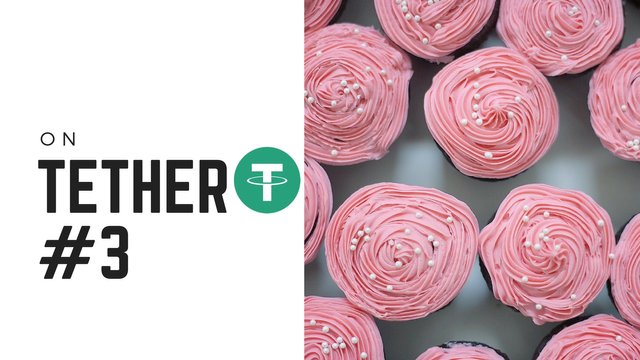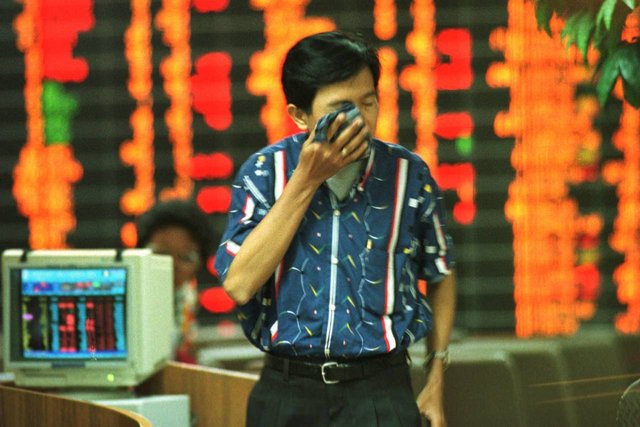On Tether: #3 A Story of How Balance Sheet Effects Bankrupted Emily's Cupcakes. Or Double Trouble if Tether is Crypto-Backed. [15 min]

Last week, I wrote two pieces explaining the Tether situation, and how analysing it as a fixed exchange rate system helps us understand the potential risks involved with it. See the posts here:
- On Tether: #1 A Tale of Two Firms - Enron, Tether, and FUD
- On Tether: #2 Lessons from Actual Currency Crises. What Tether Should Already Know.
I ended off by promising to discuss why a "currency crisis" is more likely if Tether hold its reserves in cryptos instead of in fiat, the latter being their claim. Since then, worries about Tether has been steadily rising. Here's the last piece of the puzzle, explaining why it will be really bad if Tether is backed by cryptos.
Outline
This essay is organised as follows:
- Part 1 introduces the Thai Financial Crisis.
- Part 2 explains the balance sheet effect with an illustrative story of Emily's Cupcakes, made up by me (note: no relation to any real Emily's Cupcakes out there!).
- Part 3 explains the problem for the Tether peg if reserves are held in cryptos (even if it's a moderate portion of it).
- Part 4 explains why it's profitable for Tether to hold cryptos in its reserves.

Part 1: History Always Repeat Itself - The Case of Thailand

Pictured: Thai investor during the Asian Financial Crisis, 1997.
Credits: THAKSINA KHAIKAEW/ASSOCIATED PRESS
For a deeper understanding of the Tether situation, first look to Thailand in the Asian Financial Crisis. Let's go back to 1997:
Time: Onset of Financial Crisis, 1997
Location: Bangkok, Thailand.
In 1997, the Thai Baht (THB) was pegged to the US dollar (USD) at 25 THB to 1 USD. For years, it had operated smoothly and the Thai economy had been growing at a rapid pace of an average of 9% per year for the last decade. Capital flowed in easily from overseas because the THB peg offered stability and because foreign investors wanted a piece of the pie in the growing economy. For local Thai businesses, that meant they could borrow in USD-denominated contracts to expand their business. Business was good in the growing economy, so the money started coming in and the businesses had no trouble paying back their loans. Buildings went up, employees and customers grew richer, and in turn bought more products and services. The entire system worked well.
Speculative Attack on the THB
And then it suddenly stopped working. You see, banks and businesses had grown accustomed to the availability of cheap foreign loans. Many of these loans were given out to businesses that weren't performing very well but managed to get by. All boats are lifted in a rising tide, so it didn't matter as much if your business wasn't the best at earning high rates of return; you still got the loan from the banks who didn't think that you would default on the loan. But then foreign investors started to grow concerned about the underlying fundamentals of the economy and worried about whether the THB was overvalued. They started pulling money out, selling their THB and converting it back into USD/GBP/EUR. Speculators swooped in and shorted the THB, hoping to profit from a fall in its value. The Thai central bank didn't have enough foreign reserves to buy up the excess THB that suddenly flooded the foreign exchange market, and so abandoned the peg after in 2 July, allowing the THB's value to be set by the market. Now, the financial crisis was in full force. The Thai Baht lost over half its value, and the stock market fell by 75%.
What was strange though, was that even good businesses that should have no problems paying their debts started declaring bankruptcy. The collapse was also far larger than expected, and it seemed to worsen as the THB fell. What was happening?
Part 2: Why Thailand Suffered So Much: The Balance Sheet Effects
There were undoubtedly underlying problems in the Thai economy, but it can't be said that they were serious enough to warrant such a big collapse. What later became clear was that the seeds for this particular crisis was sowed in the good days when businesses started borrowing in USD-denominated loans, and that this opened up a balance sheet effects channel which worsened and validated a currency crisis.
Here's the idea restated: Even if foreign investor's initial concerns about Thailand's economy were exaggerated or wrong (so everything was fine), the collapse would still have happened as long as enough investors thought the same way. The initial fall in the THB would have been triggered by any number of wrong reasons, but this fall would have caused other problems to emerge, and start and worsen a crisis. Then, the initial fall in THB would have been validated.
Confused? Don't worry, let's start at the beginning.
Emily's Cupcakes - Year 1 (The Start of Something New)

Emily is an amazing baker. She borrows 100 THB from her family and starts her business with the cash. All she needs is an oven that costs 80 THB. She pays for the oven in cash. Here's a simplified balance sheet at the start of Year 1:
| Assets (THB) | Liabilities (THB) |
|---|---|
| Oven 80 | - |
| Cash 20 | - |
Her family is now her shareholders, and the 100 THB she has borrowed from them becomes asset for the company to invest and earn profits for her shareholders.
Emily makes amazing cupcakes, and manages to earn a profit of 20 THB that she collects fully in cash by the end of the year. She borrows no money in Year 1. At the end of Year 1, she holds a party and reports on the success to her family. Her family decides to re-invest the profit. Her balance sheet is now (with changes in italics):
| Assets (THB) | Liabilities (THB) |
|---|---|
| Oven 80 | - |
| Cash 40 | - |
Emily's Cupcakes - Year 2 (Emily Needs a Van)

Everything is going amazingly well. At the start of Year 2, Emily notices that her customers want their cupcakes delivered. She needs 100 THB to buy a van to offer delivery services, but her family is unable to invest any more money. Luckily, she is able to get a bank loan from American Bank Ltd, which charges less interest than Thai Bank Ltd.
American Bank lends her the money in USD, and it's a 5-year loan for 4 USD=100 THB (the current peg is 1 USD=25 THB) at 10% interest rate per year. That means that Emily needs to pay 0.4 USD=10 THB at the end of each year, plus the 4 USD=100 THB amount back at the end of the 5th year. The catch is that Emily's Cupcakes has to maintain positive net assets (Assets - Liabilities > 0) or the bank will force her to return the money immediately. That's not a problem, because Emily and her bank expects her to make at least 20 THB per year by the end of that year, and more with each year. She gets the loan, buys her van for 100 THB, and gets down to business.
At the start of Year 2, Emily's balance sheet (with changes in italics):
| Assets (THB) | Liabilities (THB) |
|---|---|
| Van 100 | USD Loan 100 |
| Ovens 80 | - |
| Cash 40 | - |
It's the end of Year 2. Business is better than expected! She doubles her profits and makes 40 THB that year with the help of the new van. She pays American Bank the 0.4 USD=10 THB she owes them, and still have 30 THB left! She decides to pay the 30 THB out as dividends to her family. She holds her annual party for her family and tells them the great news. Her family is proud of her. Emily, her family, her customers, and her bank are all happy.
No change to her Balance Sheet at the end of Year 2:
| Assets (THB) | Liabilities (THB) |
|---|---|
| Van 100 | USD Loan 100 |
| Ovens 80 | - |
| Cash 40 | - |
Emily's Cupcakes - Year 3 (The Crash - Balance Sheet Effects!)

Year 3 comes and goes. Near the end of the year, she does her books and finds she has made another 40 THB! Happy, Emily picks up her phone to call her family.
Before paying American Bank, her interest fee of 0.4 USD=10 THB, her balance sheet is now:
| Assets (THB) | Liabilities (THB) |
|---|---|
| Van 100 | USD Loan 100 |
| Ovens 80 | - |
| Cash 80 | - |
While waiting, Emily hears on the TV that the Thai central bank has been forced to abandon their peg due to a speculative attack. THB depreciates. It falls in value from 1 USD=25 THB to 1 USD=100 THB, i.e. the THB falls to 1/4 of its previous value vs the USD. That's not going to matter to her right? She just made so much money and her business has so much cash in the bank!
Well, let's see. Emily is worried so she calls her accountant.
Accountant:
The 0.4 USD=10 THB interest you (Emily) have to pay American Bank is now 0.4 USD=40 THB. That's a 4 times increase.
Emily:
But I have 80 THB cash so I can pay that out and I will still be left with 40 THB right?
Accountant:
Yes... And No. Your loan from American Bank was lent out to you in USD too. So the 4 USD=100 THB loan is now 4 USD=400 THB. You used to owe them 100 THB, but now you owe them 400 THB. So (disregarding the interest payment for simplicity), your balance sheet is now:
| Assets (THB) | Liabilities (THB) |
|---|---|
| Van 100 | USD Loan 400 |
| Ovens 80 | - |
| Cash 80 | - |
Accountant:
Your contract allows American Bank to collect their money if your net assets goes negative, so in a few weeks time, you have to pay American Bank 40 THB + 400 THB = 440 THB or you have to declare bankruptcy. You only have 80 THB in cash, so you have to declare bankruptcy unless someone else lends you money to pay it back. If you do declare bankruptcy, bankruptcy laws requires that all your assets are paid out to American Bank first, then your shareholders, so the court will seize your 260 THB of assets (oven, van, cash) and your family will be left with nothing.
Emily cries.
By all accounts, Emily ran a good business. But when speculation causes the THB to fall, her liabilities ballooned. Her business turned from healthy to toxic overnight.
Now, suppose that Thailand had an economy made up of healthy firms like Emily's Cupcakes. But a small but significant number of investors wrongly interpreted Thailand's businesses and decides to short the THB. The majority of smarter investors know that the firms are great, but they start to realise that if the THB falls, these healthy firms will be unable to meet their increased debt obligations and be forced to stop business, then the Thai economy would be in a crisis and the THB should fall.
Part 3: What has this got to do with Tether?
The balance sheet effect sounds very harmless for a vicious cycle process that creates more and more damage. A better name would be The Sickening Crunch No One Heard as the Economy Collapsed.
The balance sheet effects applied to Tether:
Suppose Tether is crypto-backed. Even if they have enough reserves in crypto, if enough people think that there might be a crisis, there will be a crisis. Even if they have enough reserves in crypto, if enough people think they don't have enough reserves, then they won't have enough reserves.
Let me explain. Suppose Tether actually holds its reserves in cryptos instead of fiat as promised. So their balance sheet is
| Assets (THB) | Liabilities (THB) |
|---|---|
| Bitcoin (BTC) 2 Billion | Tether Issued 2 Billion |
There is unfounded speculation that Tether doesn't have enough reserves. I am a very conservative investor so I sell USDT for bitcoins (BTC) in the downturn because I don't want to hold something that might lose value. And I sell BTC for USD at another exchange like Coinbase. USDT price falls to 0.9 USD (by 10%); BTC price falls (by 10%). Other traders buy up the USD that I and other investors sell because they are willing to take on the risk for a possible fall in USDT prices.
Tether finds that the its crypto reserves (assets) are now worth a fraction of what it was, but its 1 USDT=1 USD liabilities to its customers are unchanged. Its balance sheet is now:
| Assets (THB) | Liabilities (THB) |
|---|---|
| Bitcoin (BTC) 1.8 Billion | Tether Issued 2 Billion |
Now, there are 2 billion Tether tokens out there backed by 1.8 billion USD worth of BTC. People start to feel uneasy. Word gets out that something might be wrong.
At some point, Tether has to step in. Tether has to buy up USDT to maintain the 1:1 peg to the USD. It does this by selling the BTC that it was holding in its reserves for USDT on Bitfinex and other exchanges. Supply of cryptos like BTC increase; price of BTC falls. In the panic, people try to convert their BTC to USD (cash!) before a larger fall in BTC prices. Supply of BTC increases more; price of BTC falls quickly.
Let's say price of BTC halves at this point.
| Assets (THB) | Liabilities (THB) |
|---|---|
| Bitcoin (BTC) 1 Billion | Tether Issued 2 Billion |
There are 2 billion Tether tokens out there backed by 1 billion USD worth of BTC. What I have not shown on the balance sheet is the effects of Tether buying up USDT with BTC. That is not necessary for this demonstration, but it will worsen the balance sheet effect because Tether has to buy USDT with more and more BTC as the price of BTC falls.
Regulators step in and finds Tether doesn't have enough reserves. They close down the business. The whole thing implodes.
Part 4: Why Tether Might Have Crypto Reserves
It's simple actually. In a rising market, Tether makes money by selling USDT in exchange for USD. Remember, Tether does not accept USD deposits.
Here's how:
Price of BTC is $1,000 ($1k)
- Create 100k USDT and sell them for 100 BTC on the exchange I control. I get 100 BTC and the buy gets 100k USDT worth $100k on the market.
- I increase my assets by 100 BTC and my liabilities by $100k.
- I've just printed money like a bank.
- I can sell my BTC for USD, but I choose to hold on to BTC because I'm sure the price will rise (or I can make the price by manipulating the market). Anyway, it's hard for me to hold on to so much USD because of my bad banking conditions.
Price of BTC is $2,000 ($2k)
- Hooray! The 100 BTC is now worth $200k but my liabilities is still $100k.
- I have $100k in profits.
- Options: I can now sell 50 BTC and party (enticing right?). OR I can hold on to all the BTC and wait for the price to increase even more.
- I do the latter.
Price of BTC is $500
- The 100 BTC is now worth $50k but my liabilities is still $100k. So I have a shortfall of $50k.
- Shit. Things didn't go as planned. What do I do now?
- Options: Face up to the music, and say I don't have enough reserves now. OR Print more USDT, buy BTC and push up BTC prices.
- Luckily, Chinese investors like to sell their BTC for USDT and hold on to them in a downturn because they can't easily bring the money back in from offshore markets. So demand for USDT is high.
- I go big and print $1 million USDT and sell it for 2000 BTC.
- My large purchase of 2000 BTC is already having an effect on the market, which thinks there's a whale buying up lots of BTC and holding on to them. I double the stakes and print another $1 million USDT for 2000 BTC.
==> I have now issued 2.1 million USDT (owing $2.1 million USD), and have 4100 BTC (worth $2.05 million USD), i.e. still a shortfall of $50k. - Now the market starts to take notice. Lots of ordinary investors think there's an upturn coming and buys. BTC price recovers to $1k.
==> Now, it's 2.1 million USDT (owing $2.1 million USD), and I have 4100 BTC (worth $4.1 million USD), i.e. $2 million of profits on paper.
I turned a loss into a profit by printing Tether!

Yeah, that's right. I'm a genius. Let's print $2 billion USDT now. What can possibly go wrong?

Like this? Here's some similar posts of mine:
- On Tether: #1 A Tale of Two Firms - Enron, Tether, and FUD
- On Tether: #2 Lessons from Actual Currency Crises. What Tether Should Already Know.
- Steemit Monetary Policy: Why the SBD Peg is Broken and How to Fix It. But Do We Really Want It?
Lastly, I post frequently about economics and my travels. Follow me to learn about economics!
Wow! You must have spent so much time writing this.
very very good wilfredn! I'm impressed with your understanding and knowledge of big issues like this. It is my personal field of experience, and you did a great job of explaining things! Keep it up!
Congratulations you have been upvoted and resteemed as part of #newbieresteemday's top 10 posts for the day! ...
We invite you to use our tag to connect with more of our members. To learn more: Come Join Us!!! (Newbie Resteem Initiative)
Thank you! Really enjoyed writing the post and glad that it's hitting some right notes =)
Your Post Has Been Featured on @Resteemable!
Feature any Steemit post using resteemit.com!
How It Works:
1. Take Any Steemit URL
2. Erase
https://3. Type
reGet Featured Instantly � Featured Posts are voted every 2.4hrs
Join the Curation Team Here | Vote Resteemable for Witness
Congratulations! This post has been upvoted from the communal account, @minnowsupport, by wilfredn from the Minnow Support Project. It's a witness project run by aggroed, ausbitbank, teamsteem, theprophet0, someguy123, neoxian, followbtcnews, and netuoso. The goal is to help Steemit grow by supporting Minnows. Please find us at the Peace, Abundance, and Liberty Network (PALnet) Discord Channel. It's a completely public and open space to all members of the Steemit community who voluntarily choose to be there.
If you would like to delegate to the Minnow Support Project you can do so by clicking on the following links: 50SP, 100SP, 250SP, 500SP, 1000SP, 5000SP.
Be sure to leave at least 50SP undelegated on your account.